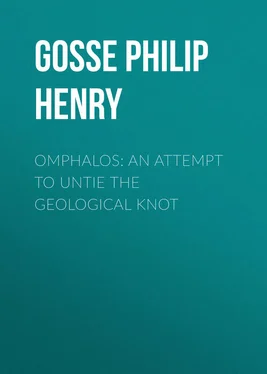Philip Gosse - Omphalos - An Attempt to Untie the Geological Knot
Здесь есть возможность читать онлайн «Philip Gosse - Omphalos - An Attempt to Untie the Geological Knot» — ознакомительный отрывок электронной книги совершенно бесплатно, а после прочтения отрывка купить полную версию. В некоторых случаях можно слушать аудио, скачать через торрент в формате fb2 и присутствует краткое содержание. Жанр: Биология, foreign_antique, foreign_prose, на английском языке. Описание произведения, (предисловие) а так же отзывы посетителей доступны на портале библиотеки ЛибКат.
- Название:Omphalos: An Attempt to Untie the Geological Knot
- Автор:
- Жанр:
- Год:неизвестен
- ISBN:нет данных
- Рейтинг книги:3 / 5. Голосов: 1
-
Избранное:Добавить в избранное
- Отзывы:
-
Ваша оценка:
- 60
- 1
- 2
- 3
- 4
- 5
Omphalos: An Attempt to Untie the Geological Knot: краткое содержание, описание и аннотация
Предлагаем к чтению аннотацию, описание, краткое содержание или предисловие (зависит от того, что написал сам автор книги «Omphalos: An Attempt to Untie the Geological Knot»). Если вы не нашли необходимую информацию о книге — напишите в комментариях, мы постараемся отыскать её.
Omphalos: An Attempt to Untie the Geological Knot — читать онлайн ознакомительный отрывок
Ниже представлен текст книги, разбитый по страницам. Система сохранения места последней прочитанной страницы, позволяет с удобством читать онлайн бесплатно книгу «Omphalos: An Attempt to Untie the Geological Knot», без необходимости каждый раз заново искать на чём Вы остановились. Поставьте закладку, и сможете в любой момент перейти на страницу, на которой закончили чтение.
Интервал:
Закладка:
The floors of limestone caverns are frequently strewn with fossil bones, which are imbedded in stalagmite, and this incrustation is still in progress of formation. It is remarkable that in this deposit alone we obtain the bones of Man in a fossil condition. The two creations, – the extinct and the extant, – or rather the prochronic and the diachronic – here unite. But there is no line of demarcation between them; they merge insensibly into each other. The bones of Man, and even his implements and fragments of pottery, are found mingled with the skeletons of extinct animals in the caves of Devonshire, in those of Brazil, 42 42 An interesting fact relating to the Brazilian caves was communicated to Dr. Mantell. "M. Claussen, in the course of his researches, discovered a cavern, the stalagmite floor of which was entire. On penetrating the sparry crust, he found the usual ossiferous bed; but pressing engagements compelled him to leave the deposit unexplored. After an interval of some years, M. Claussen again visited the cavern, and found the excavation he had made completely filled up with stalagmite, the floor being as entire as on his first entrance. On breaking through this newly-formed incrustation, it was found to be distinctly marked with lines of dark-coloured sediment, alternating with the crystalline stalactite. Reasoning on the probable cause of this appearance, M. Claussen sagaciously concluded that it arose from the alternation of the wet and dry seasons. During the drought of summer, the sand and dust of the parched land were wafted into the caves and fissures, and this earthy layer was covered during the rainy season by stalagmite, from the water that percolated through the limestone, and deposited calc-spar on the floor. The number of alternate layers of spar and sediment tallied with the years that had elapsed since his first visit; and on breaking up the ancient bed of stalagmite, he found the same natural register of the annual variations of the seasons; every layer dug through presented a uniform alternation of sediment and spar; and as the botanist ascertains the age of an ancient dicotyledonous tree from the annual circles of growth, in like manner the geologist attempted to calculate the period that had elapsed since the commencement of these ossiferous deposits of the cave; and although the inference, from want of time and means to conduct the inquiry with precision, can only be accepted as a rough calculation, yet it is interesting to learn that the time indicated by this natural chronometer, since the extinct mammalian forms were interred, amounted to many thousand years." – ( Petrifactions and their Teachings , p. 481.)
and in those of Franconia. In Peru, some scores of human skeletons have been found in a bed of travertine, associated with marine shells; the stratum itself being covered by a deep layer of vegetable soil, forming the face of a hill crowned with large trees.
From a very interesting paper by M. Marcel de Serres, it appears indubitable that the existing shells of the Mediterranean are even now passing in numbers into the fossil state, and that not in quiet spots only, but where the sea is subject to violent agitations. Specimens of common species, "completely petrified, have been converted into carbonate of lime at the same time that they have lost the animal matter which they originally contained. Their hardness and solidity are greater than those of some petrified species from tertiary formations."
"In the collection of M. Doumet, Mayor of Cette, there exists an anchor which exhibits the same circumstances, and which is also covered with a layer of solid calcareous matter. This contains specimens of Pecten , Cardium , and Ostrea , completely petrified, and the hardness of which is equal to that of fossil species from secondary formations. On the surface of the deposit in which the anchor is imbedded, there are Anomiæ and Serpulæ , which were living when the anchor was got out of the sea; these present no trace of alteration." 43 43 Bibliothèque Univers., March, 1852.
Thus we have brought down the record to an era embraced by human history, and even to individual experience; and we confidently ask, Is it possible, is it imaginable, that the whole of the phenomena which occur below the diluvial deposits can have been produced within six days, or seventeen centuries? Let us recapitulate the principal facts.
1. The crust of the earth is composed of many layers, placed one on another in regular order. All of these are solid, and most are of great density and hardness. Most of them are of vast thickness, the aggregate not being less than from seven to ten miles.
2. The earlier of these were made and consolidated before the newer were formed; for in several cases, it is demonstrable that the latter were made out of the débris of the former. Thus the compact and hard granite was disintegrated grain by grain; the component granules were rolled awhile in the sea till their angles were rubbed down; they were slowly deposited, and then consolidated in layers.
3. A similar process goes on again and again to form other strata, all occupying long time, and all presupposing the earlier ones. 44 44 "It is now admitted by all competent persons, that the formation even of those strata which are nearest the surface , must have occupied vast periods, probably millions of years, in arriving at their present state." – Babbage, Ninth Bridgewater Treatise , p. 67.
4. After some strata have been formed and solidified, convulsions force them upward, contort them, break them, split them asunder. Melted matter is driven through the outlets, fills the veins, spreads over the surface, settles into the hollows, cools and solidifies.
5. After the outflowing and consolidation of these volcanic streams, the action of running water cuts them down, cleaving beds of immense depth through their substance. Mr. Poulett Scrope, speaking of the solidified streams of basalt, in the volcanic district of Southern France, observes: —
"These ancient currents have since been corroded by rivers, which have worn through a mass of 150 feet in height, and formed a channel even in the granite rocks beneath, since the lava first flowed into the valley. In another spot, a bed of basalt, 160 feet high, has been cut through by a mountain stream. The vast excavations effected by the erosive power of currents along the valleys which feed the Ardèche, since their invasion by lava-currents, prove that even the most recent of these volcanic eruptions belong to an era incalculably remote." 45 45 Geology of Central France.
6. A series of organic beings appears, lives, generates, dies; lives, generates, dies; for thousands and thousands of successive generations. Tiny polypes gradually build up gigantic masses of coral, – mountains and reefs – microscopic foraminifera accumulate strata of calcareous sand; still more minute infusoria – forty millions to the inch – make slates, many yards thick, of their shells alone.
7. The species at length die out – a process which we have no data to measure, 46 46 "Though perfect knowledge is not possessed, yet there are reasons for believing that the duration of life to testacean individuals of the present race is several years. But who can state the proportion which the average length of life to the individual mollusc or conchifer, bears to the duration appointed by the Creator to the species? Take any one of the six or seven thousand known recent species; let it be a Buccinum , of which 120 species are ascertained, (one of which is the commonly known whelk ;) or a Cypræa , comprising about as many, (a well-known species is on almost every mantel-piece, the tiger-cowry ;) or an Ostrea ( oyster ), of which 130 species are described. We have reason to think that the individuals have a natural life of at least six or seven years; but we have no reason to suppose that any one species has died out, since the Adamic creation. May we then, for the sake of an illustrative argument, take the duration of testacean species, one with another, at one thousand times the life of the individual? May we say six thousand years? We are dealing very liberally with our opponents. Yet in examining the vertical evidences of the cessations of the fossil species, marks are found of an entire change in the forms of animal life; we find such cessations and changes to have occurred many times in the thickness of but a few hundred feet of these late-rocks." – Dr. J. Pye Smith, Scripture and Geology , 5th Ed. p. 376.
though we may reasonably conclude it very long. Sometimes the whole existing fauna seems to have come to a sudden violent end; at others, the species die out one by one. In the former case suddenly, in the latter progressively, new creatures supply the place of the old. Not only do species change; the very genera change, and change again. Forms of beings, strange beings, beings of uncouth shape, of mighty ferocity and power, of gigantic dimensions, come in, run their specific race, propagate their kinds generation after generation, – and at length die out and disappear; to be replaced by other species, each approaching nearer and nearer to familiar forms.
Интервал:
Закладка:
Похожие книги на «Omphalos: An Attempt to Untie the Geological Knot»
Представляем Вашему вниманию похожие книги на «Omphalos: An Attempt to Untie the Geological Knot» списком для выбора. Мы отобрали схожую по названию и смыслу литературу в надежде предоставить читателям больше вариантов отыскать новые, интересные, ещё непрочитанные произведения.
Обсуждение, отзывы о книге «Omphalos: An Attempt to Untie the Geological Knot» и просто собственные мнения читателей. Оставьте ваши комментарии, напишите, что Вы думаете о произведении, его смысле или главных героях. Укажите что конкретно понравилось, а что нет, и почему Вы так считаете.












